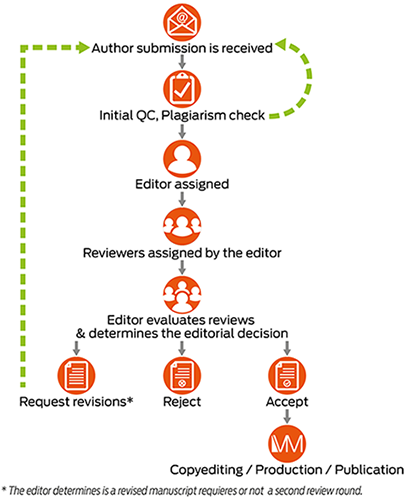Peer review process
VMOA uses a double-blind review process, whereby the identities of authors and reviewers are unknown to each other. Reviewers shall operate under the guidelines described below and are expected to have both the expertise and the time required for a thorough and objective peer review. We know reviewing a manuscript is a high-responsibility and time-consuming task. Therefore, VMOA appreciates the dedication and willingness of professionals that contribute to the quality of our publications.
Manuscript and peer review workflow
Upon submission, manuscripts are assigned to an editorial board member, checked for plagiarism, scope, and overall scientific quality. If deemed suitable for publication in VMOA, the editorial board member assigns the review to at least two qualified reviewers, as shown:

What to do when you receive the invitation to review?
- Read the e-mail from the editor requesting the review, which includes the abstract and the due date to accept the revision and to file the review report. Please, determine if the subject is within your area of expertise and if you can complete the review in the stated period.
Click the link at the end of the e-mail to access VMOA’s web page and notify the editor if you accept or reject the review request. If you are willing to review but need more time to complete it, ask the editor for an extension period.
If you reject the review request:
Please, describe your reasons for declining.
- Refer a colleague who may be able to review the submission.
- You must not transfer the review request to a colleague. If your suggestion of potential reviewers is considered appropriate, the editor will send a new invitation to that person.
If you accept the review request:
- You will have access to the complete PDF of the submission.
- Do not discuss with colleagues or cite its contents before it has been published. All information related to a manuscript and its review must be always kept confidential.
- Never ask a colleague to review the manuscript on your behalf. This practice is considered identity falsification. Instead, refer your colleague to the editor as a potential reviewer.
Conducting the review and completing the review form
Assume a positive, impartial, but critical approach toward the manuscript in review. This approach facilitates objective, accurate, and relevant scientific communication. Reviewers are not expected to judge the perceived importance or potential impact of papers. These assessments are left to the scientific community, once the paper is published. Please, consider the following aspects when reviewing a manuscript:
- Originality (if necessary, check the literature on the subject to make sure the study is not a repetition of previous experiments)
- Pertinence of experimental design (or approach) and statistical analysis of data
- Adequacy of methods and experimental techniques
- Relevance of discussion
- Soundness of conclusions and interpretation of results
- If you consider that the statistical analysis of data is inappropriate or that the statements/conclusions are not supported by results, provide a brief explanation supporting these judgments
- Adequacy of title and abstract
- Appropriateness of figures, tables, and supplemental material (if applicable)
- Length of the manuscript
- Whether there is evidence of manipulation of images, conflict of interest or ethical concerns related to experimental subjects (i. e. animals, humans)
- Is experimental data fully accessible to readers?
- Notice that a very limited number of papers qualify for an immediate acceptance.
Manuscripts may be rejected for multiple reasons. The most frequent ones include serious flaws in experiment design and analysis, extensive additional experiments required before it can be published, lack of organization or poor English usage that prevent critical review of the paper. If you observed these extensive deficiencies, recommend the manuscript be rejected.
If you think that the deficiencies can be resolved within a reasonable period of time, then recommend either “Resubmit for review” (if the paper needs a major revision) or “Request revisions” (if it requires a minor revision).
You may also choose to recommend “Accept as a short communication” if the paper does not meet full research article features. Please, notice that this format is not meant to allow publishing studies of doubtful scientific quality. It must meet the features of a short-communication paper, such as reporting the discovery or development of a new theory, confirmatory results in other settings, as well as negative results.
Completing the “Comments to author” section
Provide a constructive and thorough review of the sections. So, that the authors can prepare a revision ready for acceptance without incurring in multiple revision rounds.
- Start with an introductory paragraph summarizing your overall impression of the manuscript, and its major limitations (if any). After this introduction, place your specific, numbered comments, citing sections and line numbers when appropriate. Numbering of comments is important as it greatly facilitates the elaboration of the editor’s decision letter, as well as the evaluation of the author’s response to reviewers.
- Your comments will be very useful for both the editor and the author if they are well documented. Avoid making dogmatic or subjective statements, particularly about the novelty of the work and always substantiate your comments.
- Avoid unspecific and/or subjective observations such as “I do not like the idea…”, “everything is wrong”, etc.
- Reviewers are not expected to correct deficiencies of style or grammar. However, feel free to point out the use of scientific jargon, misspellings of chemical names, incorrect genetic nomenclature, use of outdated taxonomy, etc.
- Offensive remarks are not acceptable. Please, always present your criticism objectively and dispassionately.
- Unless offensive remarks are included, reviewers’ comments are not edited before sending them to the authors. Therefore, carefully check your comments to make sure they are well written and are easy to understand.
- Although reviewers are asked to recommend an editorial decision, DO NOT make statements on the acceptability of a manuscript in this section. Please, indicate your recommendation by selecting it from the dropdown list on the journal web page. The editorial decision of each manuscript is the sole responsibility of the editor.
Completing the “Comments to editor” section
Include a brief report stating your general appraisal of the paper and substantiate your comments. Advise the editor of your recommendation to accept, request revisions, or reject the manuscript by selecting your recommendation from the dropdown list. Remember that the final editorial decision relies with the editor. Therefore, DO NOT include your recommendation in your comments to the author.
After completing the review form, you must submit it by clicking on the “Submit review” button.
VMOA editorial policies that should be considered by reviewers
- Plagiarism and attribution. Previous publications must be properly attributed, even if they were made by the same authors. Therefore, authors must clearly differentiate their ideas, concepts, and data, etc., from those from previous publications, and cite the corresponding references. In case of non-compliance, reviewers must report it to the editor.
- Data availability compliance. All data derived from the research must be made accessible to readers. This policy may be accomplished either by providing the accession numbers of data deposited in public repositories, or by including the data as supplementary information. If reviewers detect missing or insufficient information, they must report it to the editor.
- Zero tolerance for salami science practices. Redundant or segmented publications (same hypothesis, methods, and results, but different text) pose a threat to publication ethics. These practices are difficult to detect with plagiarism software, and thus, we expect reviewers to adopt a critical approach in this regard (i. e. check literature citations, or run the abstract in some web-based tools, such as Jane (Journal/Author Name Estimator): https://jane.biosemantics.org/). Please, report to the editor any evidence of redundant or segmented publications.
- Conflict of interest. Reviewers must bring to the attention of the editor any signs of conflicts of interest. Especially, if there are indications that the research is intentionally biased to favor commercial interests.


